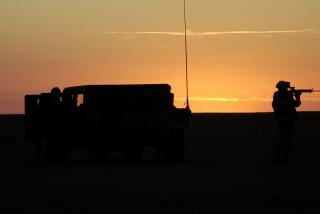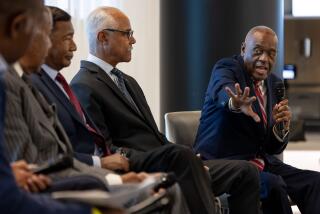Today’s Pattons Face Moment of Truth : Combat: The outcome of any ground war will likely hinge on the decisions of a handful of allied generals.
- Share via
WITH U.S. FORCES, Saudi Arabia — If it must be, finally, a great armored battle in the sand to settle the Persian Gulf War, the outcome is likely to bear the handwriting of some lone officer. Up along the front lines, probably in the pitch dark of night, under the rage of open-field warfare, this commander will sound an order--an order he has prepared his whole life to give.
By the quality of his judgment, the caliber of his leadership, the determination of his troops and, indeed, the measure of good luck he carries, the tide of this “mother of battles” will turn.
So will an anxious nation’s hope for a ground war with light casualties and a fast resolution.
Desert warfare tests not just equipment. It’s the stuff to test the front-line generals. George S. Patton. Viscount Bernard Law Montgomery. Erwin Rommel. These storied field commanders of half a century ago all emerged out of the early and bloody armored desert fighting of World War II. That was the last time America found itself on a battlefield with so much lethal armor.
For all the obvious reasons, tanks in the desert raise ground combat to its most fearsome and perhaps its highest level: vast open spaces, huge mobile armies, computer-fast weaponry and firepower of unimaginable fury.
It’s no wonder that, as eyes drop from the skies to the sandy horizon at ground level in the Persian Gulf War, conversations like this can be overhead around Central Command headquarters in Riyadh, Saudi Arabia:
“Wonder if we’ve got any Pattons up there?”
“I hope so.”
In World War II, the long unfolding of campaigns allowed the Army to test its generals under fire. Some, though adept at traversing the corridors of the Pentagon, proved unsatisfactory for the life-and-death demands of combat leadership.
But this kind of on-the-job testing is incompatible, in this war, with the strategy and aims of political leaders in the United States and other coalition countries.
So for good or ill, the burden rests with men named Paul Funk, Ronald Griffith and Barry McCaffrey and a handful of others, the warrior generals of the Persian Gulf.
They now are known, largely, only in the clubby circles of the military today.
But tomorrow. . . .
“Armored battle at any scale in this war will be incredibly fast, incredibly violent and incredibly heroic. Or incredibly disastrous,” says one Army officer in Central Command. “And if the scale is all out, it will be like nothing ever seen.”
Commanding Gen. H. Norman Schwarzkopf and the brass in the Pentagon and Riyadh war rooms, of course, will devise the battle plan and its many contingencies. But at some point after the engagement begins, the decisions and adjustments in execution will pass inexorably to those officers on the front.
For years, the Pentagon has promoted the doctrine of individual initiative. Even Americans far removed from the military have probably heard that potential adversaries, particularly the Soviets and now the Soviet-trained Iraqis, suffer from overcentralized commands, while U.S. officers enjoy the freedom to move and exploit conditions on their own initiative.
Officers here, in fact, say there are plenty of limits circumscribing that freedom in this age of high-tech communications and dense layers of command.
But with an armored battle expected to occur faster and with greater firepower than ever in history, field commanders at two levels, in particular, will be called upon for the judgments on which medals or, conversely, casualties are earned.
Army tactics strongly emphasize mobile, armored battalions. Much of the training in Europe has envisioned battalion-level movements.
But perhaps more important in this open-field desert theater, and the subject of exhaustive training here, has been movements of larger units, the armored divisions.
The Marines also are deployed by division, although none match the armor of the Army’s heavy divisions. And the Marines are at sea in a pair of Marine Expeditionary Forces, also with lighter armor.
Here are sketches of some of the front-line fighting generals, any one of whom, by fate and deed, could affect the turn of battle:
* PAUL E. FUNK
Major general, U.S. Army; commander, 3rd Armored Division.
One of two heavy armored divisions on the front line, the 3rd is as close to a desert division as the Army has. And Funk, 51, of Roundup, Mont., is regarded as one of the Army’s most experienced desert generals; he is the former commander of the National Training Center, at Ft. Irwin in the Mojave Desert.
“The desert suits the 3rd Armored Division, and so does fighting in it,” he says. “If we’re going to do it anywhere, we’re suited for this place.”
Troops under Funk have been made to forgo even basic necessities in the division’s rigorous training program until they learned to regard the desert vastness as friend, not foe.
“These guys can take this stuff,” Funk says, waving off the hardships and grave dangers of the Arabian desert. “We think we’re up to the task, but talking ain’t fighting. We’ll see how we did after the war is over.”
Funk, an armored officer from the start of his career, also has been a helicopter pilot. From a 15-month tour in Vietnam, he earned the Distinguished Flying Cross, the Legion of Merit and the Army Air Medal with combat V.
* RONALD H. GRIFFITH
Major general, U.S. Army; commander, 1st Armored Division.
Griffith, 54, of LaFayette, Ga., is a onetime medical assistant and divisional assistant sports officer who distinguished himself in combat in Vietnam, first as an adviser to the Regional Forces of the South Vietnamese Army, then with the U.S. 4th Infantry Division.
He holds the Bronze Star with combat V for valor and the Purple Heart.
Like the 3rd, the 1st Armored is a heavy tank division, fielding the best of the Army’s M1-A1 main battle tanks.
Griffith’s background includes both troop commands and staff positions and two years as an assistant professor of military science at UC Santa Barbara.
* BARRY R. McCAFFREY
Major general, U.S. Army; commander, 24th Infantry Division (Mechanized).
Because of his extensive record, McCaffrey was a larger-than-life hero before the war even started.
He commanded an infantry platoon in combat in the Dominican Republic and served two tours in Vietnam, as parachute infantry battalion adviser to the Vietnamese and as an air assault infantry company commander in the 1st Cavalry Division.
He was twice awarded the Distinguished Service Cross, the Army’s second-highest decoration for valor; twice the Silver Star for valor, the next-highest decoration. Three times he won the Bronze Star with combat V for valor. He was wounded three times and required long hospitalization for one wound.
McCaffrey taught American government and politics at West Point, commanded a mechanized infantry battalion in Germany and held staff assignments at the North Atlantic Treaty Organization and in the office of the U.S. Army chief of staff.
He has a son serving as a lieutenant in the 82nd Airborne and a daughter who is an Army nurse.
The 24th Infantry is a combination of an old-fashioned, foot-soldier division and a modern armored unit--the Army’s heaviest division, its Rapid Deployment Force. It was one of the most heavily decorated divisions to serve in the Korean War, its officers and men earning a combined nine Medals of Honor, 104 Distinguished Service Crosses, 942 Silver Stars and 1,277 Bronze Stars.
* THOMAS G. RHAME
Major general, U.S. Army; commander, 1st Infantry Division (Mechanized).
The 1st is another of the heavy, mobile infantry divisions of the modern Army. Rhame, 50, of Winnfield, La., served two tours in Vietnam--as a company commander with the 12th Cavalry and as a senior district adviser with the South Vietnamese Army.
Rhame was educated as an accountant and holds an MBA in comptrollership. He has earned his stars commanding virtually every level of fighting unit in the army--an infantry platoon, a cavalry company, an armored battalion, an infantry brigade and now a mechanized infantry division.
He holds two Silver Stars for valor, the Legion of Merit and the Bronze Star with combat V.
* WILLIAM M. KEYS
Major general, U.S. Marines; commander, 2nd Marine Division.
Marines combine their armor, infantry and artillery into their divisions. The 2nd Marine Division is one of two deployed on the ground in the Gulf War. Keyes, a native of Fredericktown, Pa., served two terms in Vietnam--one as a company commander and another as an adviser to the South Vietnamese Marines.
He holds the Navy Cross, the valor medal just below the Medal of Honor; the Silver Star; the Legion of Merit with combat V, and the Bronze Star with combat V for valor.
* JAMES M. MYATT
Major general, U.S. Marines; commander, 1st Marine Division.
Myatt, 50, of San Francisco, served two combat tours in Vietnam, one as an adviser to the South Vietnamese Marines and the other as a platoon and company commander. He holds a bachelor’s degree in physics and a master’s degree in engineering electronics.
* HARRY W. JENKINS JR.
Major general, U.S. Marines; commander, 4th Marine Expeditionary Brigade.
* PETER J. ROWE
Brigadier general, U.S. Marines; commander, 5th Marine Expeditionary Brigade.
The 4th and 5th expeditionary brigades are the two amphibious assault units that arrived aboard ships in the Persian Gulf. These units bring combined infantry, artillery and armored firepower for helicopter and seaborne landings. They are significantly smaller and lighter than Army armored or mechanized divisions.
Jenkins and Rowe are both 52. Jenkins, of Oakland, and Rowe, of Stamford, Conn., each served in Vietnam and hold the Bronze Star medal with combat V.
* R.A. SMITH
Major general, British army; commander of the 1st Armored Division.
This division from Great Britain contains two brigades, instead of the standard three. But the British, and their Challenger main battle tanks, are among the most highly regarded in the coalition.
Smith, 47, was commissioned a paratrooper and served with British forces in Africa, South America, the Mideast, Malaysia and Australia.
Times researcher Nona Yates in Los Angeles contributed to this story.
More to Read
Sign up for Essential California
The most important California stories and recommendations in your inbox every morning.
You may occasionally receive promotional content from the Los Angeles Times.













